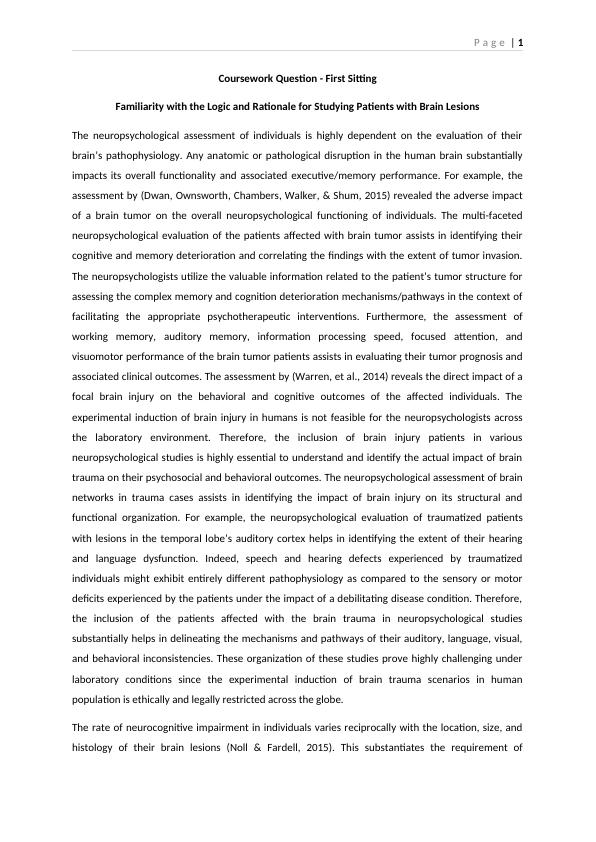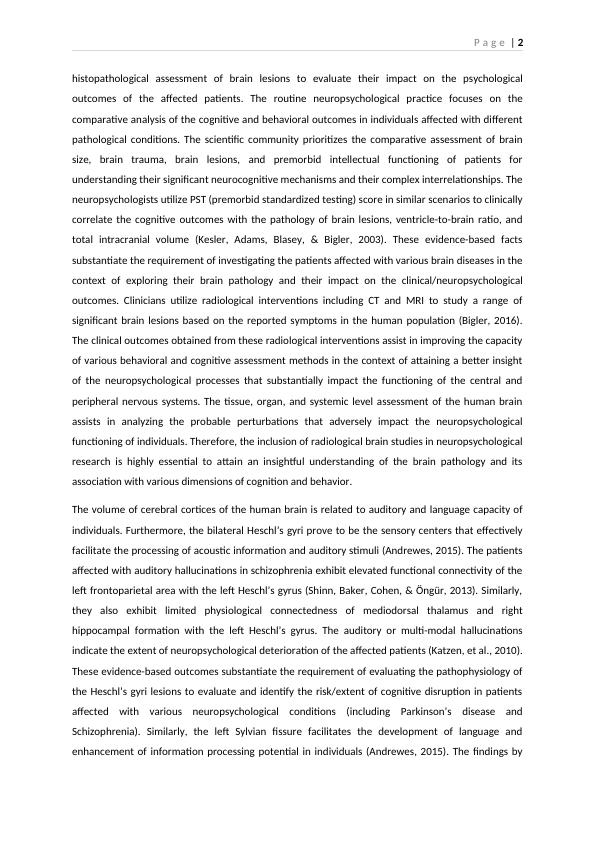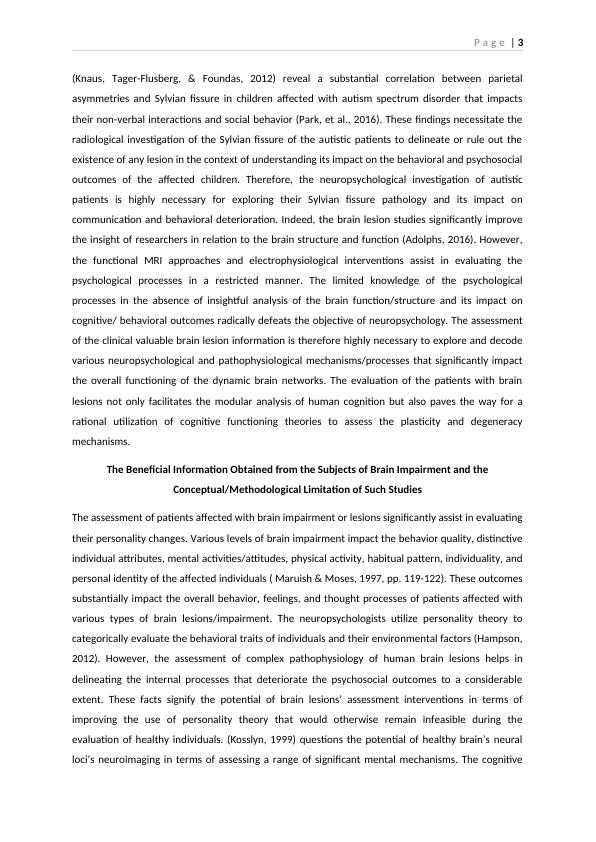Familiarity with Brain Lesions and Neuropsychological Assessment
Added on 2023-06-01
8 Pages3309 Words287 Views
P a g e | 1
Coursework Question - First Sitting
Familiarity with the Logic and Rationale for Studying Patients with Brain Lesions
The neuropsychological assessment of individuals is highly dependent on the evaluation of their
brain’s pathophysiology. Any anatomic or pathological disruption in the human brain substantially
impacts its overall functionality and associated executive/memory performance. For example, the
assessment by (Dwan, Ownsworth, Chambers, Walker, & Shum, 2015) revealed the adverse impact
of a brain tumor on the overall neuropsychological functioning of individuals. The multi-faceted
neuropsychological evaluation of the patients affected with brain tumor assists in identifying their
cognitive and memory deterioration and correlating the findings with the extent of tumor invasion.
The neuropsychologists utilize the valuable information related to the patient’s tumor structure for
assessing the complex memory and cognition deterioration mechanisms/pathways in the context of
facilitating the appropriate psychotherapeutic interventions. Furthermore, the assessment of
working memory, auditory memory, information processing speed, focused attention, and
visuomotor performance of the brain tumor patients assists in evaluating their tumor prognosis and
associated clinical outcomes. The assessment by (Warren, et al., 2014) reveals the direct impact of a
focal brain injury on the behavioral and cognitive outcomes of the affected individuals. The
experimental induction of brain injury in humans is not feasible for the neuropsychologists across
the laboratory environment. Therefore, the inclusion of brain injury patients in various
neuropsychological studies is highly essential to understand and identify the actual impact of brain
trauma on their psychosocial and behavioral outcomes. The neuropsychological assessment of brain
networks in trauma cases assists in identifying the impact of brain injury on its structural and
functional organization. For example, the neuropsychological evaluation of traumatized patients
with lesions in the temporal lobe’s auditory cortex helps in identifying the extent of their hearing
and language dysfunction. Indeed, speech and hearing defects experienced by traumatized
individuals might exhibit entirely different pathophysiology as compared to the sensory or motor
deficits experienced by the patients under the impact of a debilitating disease condition. Therefore,
the inclusion of the patients affected with the brain trauma in neuropsychological studies
substantially helps in delineating the mechanisms and pathways of their auditory, language, visual,
and behavioral inconsistencies. These organization of these studies prove highly challenging under
laboratory conditions since the experimental induction of brain trauma scenarios in human
population is ethically and legally restricted across the globe.
The rate of neurocognitive impairment in individuals varies reciprocally with the location, size, and
histology of their brain lesions (Noll & Fardell, 2015). This substantiates the requirement of
Coursework Question - First Sitting
Familiarity with the Logic and Rationale for Studying Patients with Brain Lesions
The neuropsychological assessment of individuals is highly dependent on the evaluation of their
brain’s pathophysiology. Any anatomic or pathological disruption in the human brain substantially
impacts its overall functionality and associated executive/memory performance. For example, the
assessment by (Dwan, Ownsworth, Chambers, Walker, & Shum, 2015) revealed the adverse impact
of a brain tumor on the overall neuropsychological functioning of individuals. The multi-faceted
neuropsychological evaluation of the patients affected with brain tumor assists in identifying their
cognitive and memory deterioration and correlating the findings with the extent of tumor invasion.
The neuropsychologists utilize the valuable information related to the patient’s tumor structure for
assessing the complex memory and cognition deterioration mechanisms/pathways in the context of
facilitating the appropriate psychotherapeutic interventions. Furthermore, the assessment of
working memory, auditory memory, information processing speed, focused attention, and
visuomotor performance of the brain tumor patients assists in evaluating their tumor prognosis and
associated clinical outcomes. The assessment by (Warren, et al., 2014) reveals the direct impact of a
focal brain injury on the behavioral and cognitive outcomes of the affected individuals. The
experimental induction of brain injury in humans is not feasible for the neuropsychologists across
the laboratory environment. Therefore, the inclusion of brain injury patients in various
neuropsychological studies is highly essential to understand and identify the actual impact of brain
trauma on their psychosocial and behavioral outcomes. The neuropsychological assessment of brain
networks in trauma cases assists in identifying the impact of brain injury on its structural and
functional organization. For example, the neuropsychological evaluation of traumatized patients
with lesions in the temporal lobe’s auditory cortex helps in identifying the extent of their hearing
and language dysfunction. Indeed, speech and hearing defects experienced by traumatized
individuals might exhibit entirely different pathophysiology as compared to the sensory or motor
deficits experienced by the patients under the impact of a debilitating disease condition. Therefore,
the inclusion of the patients affected with the brain trauma in neuropsychological studies
substantially helps in delineating the mechanisms and pathways of their auditory, language, visual,
and behavioral inconsistencies. These organization of these studies prove highly challenging under
laboratory conditions since the experimental induction of brain trauma scenarios in human
population is ethically and legally restricted across the globe.
The rate of neurocognitive impairment in individuals varies reciprocally with the location, size, and
histology of their brain lesions (Noll & Fardell, 2015). This substantiates the requirement of

P a g e | 2
histopathological assessment of brain lesions to evaluate their impact on the psychological
outcomes of the affected patients. The routine neuropsychological practice focuses on the
comparative analysis of the cognitive and behavioral outcomes in individuals affected with different
pathological conditions. The scientific community prioritizes the comparative assessment of brain
size, brain trauma, brain lesions, and premorbid intellectual functioning of patients for
understanding their significant neurocognitive mechanisms and their complex interrelationships. The
neuropsychologists utilize PST (premorbid standardized testing) score in similar scenarios to clinically
correlate the cognitive outcomes with the pathology of brain lesions, ventricle-to-brain ratio, and
total intracranial volume (Kesler, Adams, Blasey, & Bigler, 2003). These evidence-based facts
substantiate the requirement of investigating the patients affected with various brain diseases in the
context of exploring their brain pathology and their impact on the clinical/neuropsychological
outcomes. Clinicians utilize radiological interventions including CT and MRI to study a range of
significant brain lesions based on the reported symptoms in the human population (Bigler, 2016).
The clinical outcomes obtained from these radiological interventions assist in improving the capacity
of various behavioral and cognitive assessment methods in the context of attaining a better insight
of the neuropsychological processes that substantially impact the functioning of the central and
peripheral nervous systems. The tissue, organ, and systemic level assessment of the human brain
assists in analyzing the probable perturbations that adversely impact the neuropsychological
functioning of individuals. Therefore, the inclusion of radiological brain studies in neuropsychological
research is highly essential to attain an insightful understanding of the brain pathology and its
association with various dimensions of cognition and behavior.
The volume of cerebral cortices of the human brain is related to auditory and language capacity of
individuals. Furthermore, the bilateral Heschl’s gyri prove to be the sensory centers that effectively
facilitate the processing of acoustic information and auditory stimuli (Andrewes, 2015). The patients
affected with auditory hallucinations in schizophrenia exhibit elevated functional connectivity of the
left frontoparietal area with the left Heschl’s gyrus (Shinn, Baker, Cohen, & Öngür, 2013). Similarly,
they also exhibit limited physiological connectedness of mediodorsal thalamus and right
hippocampal formation with the left Heschl’s gyrus. The auditory or multi-modal hallucinations
indicate the extent of neuropsychological deterioration of the affected patients (Katzen, et al., 2010).
These evidence-based outcomes substantiate the requirement of evaluating the pathophysiology of
the Heschl’s gyri lesions to evaluate and identify the risk/extent of cognitive disruption in patients
affected with various neuropsychological conditions (including Parkinson’s disease and
Schizophrenia). Similarly, the left Sylvian fissure facilitates the development of language and
enhancement of information processing potential in individuals (Andrewes, 2015). The findings by
histopathological assessment of brain lesions to evaluate their impact on the psychological
outcomes of the affected patients. The routine neuropsychological practice focuses on the
comparative analysis of the cognitive and behavioral outcomes in individuals affected with different
pathological conditions. The scientific community prioritizes the comparative assessment of brain
size, brain trauma, brain lesions, and premorbid intellectual functioning of patients for
understanding their significant neurocognitive mechanisms and their complex interrelationships. The
neuropsychologists utilize PST (premorbid standardized testing) score in similar scenarios to clinically
correlate the cognitive outcomes with the pathology of brain lesions, ventricle-to-brain ratio, and
total intracranial volume (Kesler, Adams, Blasey, & Bigler, 2003). These evidence-based facts
substantiate the requirement of investigating the patients affected with various brain diseases in the
context of exploring their brain pathology and their impact on the clinical/neuropsychological
outcomes. Clinicians utilize radiological interventions including CT and MRI to study a range of
significant brain lesions based on the reported symptoms in the human population (Bigler, 2016).
The clinical outcomes obtained from these radiological interventions assist in improving the capacity
of various behavioral and cognitive assessment methods in the context of attaining a better insight
of the neuropsychological processes that substantially impact the functioning of the central and
peripheral nervous systems. The tissue, organ, and systemic level assessment of the human brain
assists in analyzing the probable perturbations that adversely impact the neuropsychological
functioning of individuals. Therefore, the inclusion of radiological brain studies in neuropsychological
research is highly essential to attain an insightful understanding of the brain pathology and its
association with various dimensions of cognition and behavior.
The volume of cerebral cortices of the human brain is related to auditory and language capacity of
individuals. Furthermore, the bilateral Heschl’s gyri prove to be the sensory centers that effectively
facilitate the processing of acoustic information and auditory stimuli (Andrewes, 2015). The patients
affected with auditory hallucinations in schizophrenia exhibit elevated functional connectivity of the
left frontoparietal area with the left Heschl’s gyrus (Shinn, Baker, Cohen, & Öngür, 2013). Similarly,
they also exhibit limited physiological connectedness of mediodorsal thalamus and right
hippocampal formation with the left Heschl’s gyrus. The auditory or multi-modal hallucinations
indicate the extent of neuropsychological deterioration of the affected patients (Katzen, et al., 2010).
These evidence-based outcomes substantiate the requirement of evaluating the pathophysiology of
the Heschl’s gyri lesions to evaluate and identify the risk/extent of cognitive disruption in patients
affected with various neuropsychological conditions (including Parkinson’s disease and
Schizophrenia). Similarly, the left Sylvian fissure facilitates the development of language and
enhancement of information processing potential in individuals (Andrewes, 2015). The findings by

P a g e | 3
(Knaus, Tager-Flusberg, & Foundas, 2012) reveal a substantial correlation between parietal
asymmetries and Sylvian fissure in children affected with autism spectrum disorder that impacts
their non-verbal interactions and social behavior (Park, et al., 2016). These findings necessitate the
radiological investigation of the Sylvian fissure of the autistic patients to delineate or rule out the
existence of any lesion in the context of understanding its impact on the behavioral and psychosocial
outcomes of the affected children. Therefore, the neuropsychological investigation of autistic
patients is highly necessary for exploring their Sylvian fissure pathology and its impact on
communication and behavioral deterioration. Indeed, the brain lesion studies significantly improve
the insight of researchers in relation to the brain structure and function (Adolphs, 2016). However,
the functional MRI approaches and electrophysiological interventions assist in evaluating the
psychological processes in a restricted manner. The limited knowledge of the psychological
processes in the absence of insightful analysis of the brain function/structure and its impact on
cognitive/ behavioral outcomes radically defeats the objective of neuropsychology. The assessment
of the clinical valuable brain lesion information is therefore highly necessary to explore and decode
various neuropsychological and pathophysiological mechanisms/processes that significantly impact
the overall functioning of the dynamic brain networks. The evaluation of the patients with brain
lesions not only facilitates the modular analysis of human cognition but also paves the way for a
rational utilization of cognitive functioning theories to assess the plasticity and degeneracy
mechanisms.
The Beneficial Information Obtained from the Subjects of Brain Impairment and the
Conceptual/Methodological Limitation of Such Studies
The assessment of patients affected with brain impairment or lesions significantly assist in evaluating
their personality changes. Various levels of brain impairment impact the behavior quality, distinctive
individual attributes, mental activities/attitudes, physical activity, habitual pattern, individuality, and
personal identity of the affected individuals ( Maruish & Moses, 1997, pp. 119-122). These outcomes
substantially impact the overall behavior, feelings, and thought processes of patients affected with
various types of brain lesions/impairment. The neuropsychologists utilize personality theory to
categorically evaluate the behavioral traits of individuals and their environmental factors (Hampson,
2012). However, the assessment of complex pathophysiology of human brain lesions helps in
delineating the internal processes that deteriorate the psychosocial outcomes to a considerable
extent. These facts signify the potential of brain lesions’ assessment interventions in terms of
improving the use of personality theory that would otherwise remain infeasible during the
evaluation of healthy individuals. (Kosslyn, 1999) questions the potential of healthy brain’s neural
loci’s neuroimaging in terms of assessing a range of significant mental mechanisms. The cognitive
(Knaus, Tager-Flusberg, & Foundas, 2012) reveal a substantial correlation between parietal
asymmetries and Sylvian fissure in children affected with autism spectrum disorder that impacts
their non-verbal interactions and social behavior (Park, et al., 2016). These findings necessitate the
radiological investigation of the Sylvian fissure of the autistic patients to delineate or rule out the
existence of any lesion in the context of understanding its impact on the behavioral and psychosocial
outcomes of the affected children. Therefore, the neuropsychological investigation of autistic
patients is highly necessary for exploring their Sylvian fissure pathology and its impact on
communication and behavioral deterioration. Indeed, the brain lesion studies significantly improve
the insight of researchers in relation to the brain structure and function (Adolphs, 2016). However,
the functional MRI approaches and electrophysiological interventions assist in evaluating the
psychological processes in a restricted manner. The limited knowledge of the psychological
processes in the absence of insightful analysis of the brain function/structure and its impact on
cognitive/ behavioral outcomes radically defeats the objective of neuropsychology. The assessment
of the clinical valuable brain lesion information is therefore highly necessary to explore and decode
various neuropsychological and pathophysiological mechanisms/processes that significantly impact
the overall functioning of the dynamic brain networks. The evaluation of the patients with brain
lesions not only facilitates the modular analysis of human cognition but also paves the way for a
rational utilization of cognitive functioning theories to assess the plasticity and degeneracy
mechanisms.
The Beneficial Information Obtained from the Subjects of Brain Impairment and the
Conceptual/Methodological Limitation of Such Studies
The assessment of patients affected with brain impairment or lesions significantly assist in evaluating
their personality changes. Various levels of brain impairment impact the behavior quality, distinctive
individual attributes, mental activities/attitudes, physical activity, habitual pattern, individuality, and
personal identity of the affected individuals ( Maruish & Moses, 1997, pp. 119-122). These outcomes
substantially impact the overall behavior, feelings, and thought processes of patients affected with
various types of brain lesions/impairment. The neuropsychologists utilize personality theory to
categorically evaluate the behavioral traits of individuals and their environmental factors (Hampson,
2012). However, the assessment of complex pathophysiology of human brain lesions helps in
delineating the internal processes that deteriorate the psychosocial outcomes to a considerable
extent. These facts signify the potential of brain lesions’ assessment interventions in terms of
improving the use of personality theory that would otherwise remain infeasible during the
evaluation of healthy individuals. (Kosslyn, 1999) questions the potential of healthy brain’s neural
loci’s neuroimaging in terms of assessing a range of significant mental mechanisms. The cognitive

End of preview
Want to access all the pages? Upload your documents or become a member.
Related Documents
Memory Deficit in Traumatic Brain Injury | Reportlg...
|11
|2735
|15
Pathophysiology of Concussive Injuries and Treatmentlg...
|5
|782
|65
